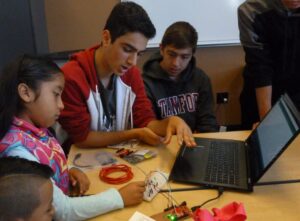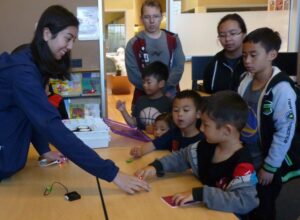A summary from three members of the STEM Ecosystem National Community of Practice
How can we truly understand learners’ perspectives to fully engage youth in the design of our movements and programs?
The STEM Ecosystem approach puts the learner at the center, but explicit effort is needed to actually incorporate youth ideas and views. Why spend this extra time and energy? Incorporating youth feedback can bring creativity and innovation to programs, and helps ensure other youth will find the topics and activities relevant. Furthermore, the youth involved in program design will develop a range of 21st century skills, from leadership to communication.

The Bay Area STEM Ecosystem, along with Tulsa Regional STEM Alliance and STEMOregon, gathered a few Ecosystems that actively seek out and incorporate youth voice at the recent STEM Ecosystem Community of Practice meeting in Tampa to develop a list of best practices. When starting out, here are a few things to keep in mind:
Be aware of youth time and capacity.
From sports to homework, today’s youth have a lot on their plates already. When developing a plan for their involvement, be aware of their constraints and realistic about how much to ask of them. Establish a timeline with specific commitments and end-dates, and acknowledge their transportation and food needs. Also consider the time of day — instead of competing with regular after-school commitments like sports or jobs, try to make use of half-days or lunch periods.
Propose concrete goals and give ownership.
Just as you would with a traditional committee of adults, respect their ideas and give weight to their feedback. If youth are serving as advisors, take the time to *listen to understand* their opinions. Furthermore, many youth will want to be involved in a more concrete way than “just talk.” While a framework or similar ideas can be helpful to get them started, encourage them to be innovative and think outside the box — we want the creativity they can provide! Finally, give them the freedom to fail — that ownership will lead to their buy-in and a real commitment.
Consider involving “non-traditional” STEM-interested students.

Think about the ways you might be unintentionally selecting for a certain type of student. Asking for volunteers excludes students who need to contribute to family finances, so consider offering paid positions or school credit for their time. Peer elections are another way to include perspectives from another type of student — and if you are able to get buy-in from the most popular students, their reach and networks can be a huge bonus to programs. Finally, consider intentionally creating a “mixed” group of students. Asking underserved and underrepresented students to work alongside highly-involved students can set up a situation where they learn from each other, and will serve to bring that much more relevance to your programs.
Authentically involving youth can become a mutually beneficial endeavor that brings real meaning to communities.
For more information or to chat further please feel free to reach out!
Emily Dilger, PhD (edilger@calacademy.org)
Emily is the coordinator of the Bay Area STEM Ecosystem, where she manages informal science education programs while building a network passionate about enhancing STEM rich learning opportunities in the underserved community of South San Francisco. With a PhD in neuroscience, her experience ranges from managing BrainFacts.org — a public information website about the brain, to developing a communication training program for scientists.

